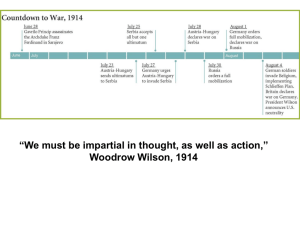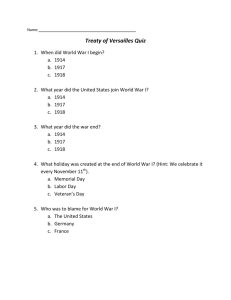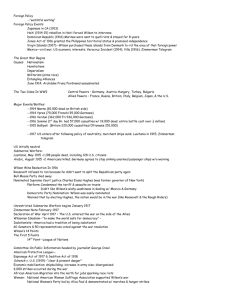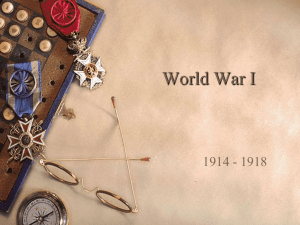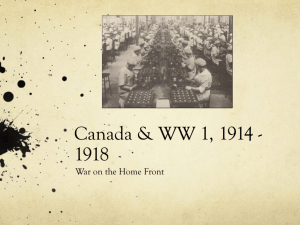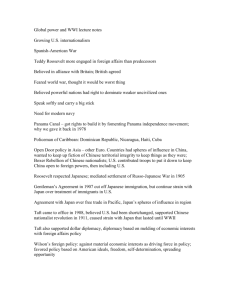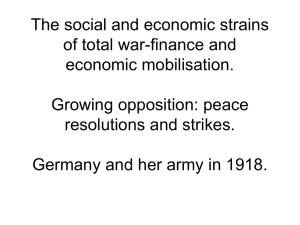THE PRESIDENCY OF WOODROW WILSON
advertisement
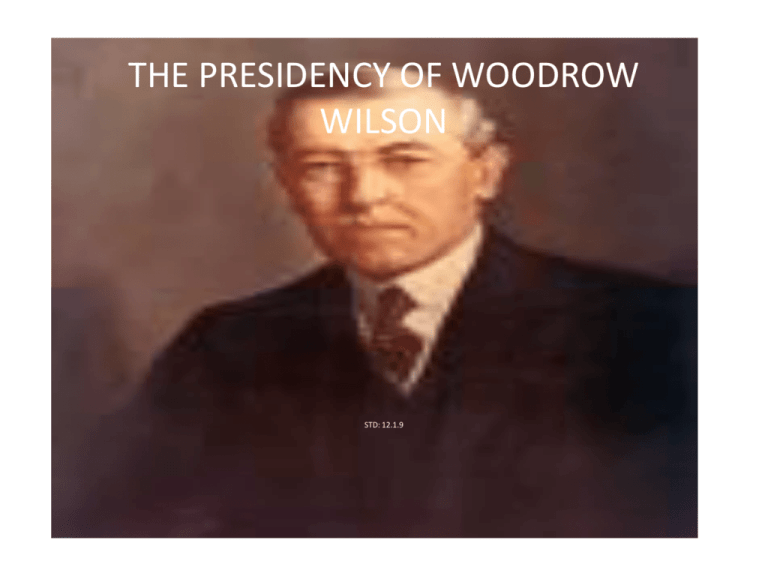
THE PRESIDENCY OF WOODROW WILSON STD: 12.1.9 ELECTION OF 1912 • • • • • • • • CANDIDATES: REPUBLICAN PARTY– WILLIAM H. TAFT DEMOCRATIC PARTY– WOODROW WILSON PROGRESSIVE PARTY (BULL MOOSE PARTY)– THEODORE ROOSEVELT SOCIALIST PARTY– EUGENE V. DEBS PLATFORMS AND ISSUES: REPUBLICAN PARTY– CONTINUE FOLLOWING TAFT’S CAREFUL “PROGRESSIVISM” DEMOCRATIC PARTY-- “NEW FREEDOM” – – – – • PROGRESSIVE PARTY– “ NEW NATIONALISM” – – – – – • FED. GOVT. SHOULD RESTORE COMPETITION RATHER REGULATE MONOPOLIES. LOWER TARIFFS BREAK UP POWERFUL WALL STREET BANKS WITH BANKING REGULATIONS. RETURN SOCIAL PROGRAMS TO THE STATES. SOCIAL JUSTICE GRADUATED INCOME TAXES WORKMEN’S COMPENSATION CHILD LABOR WOMEN’S RIGHTS ELECTION RESULTS: WILSON’S FIRST TERM • Inaugural Address • Special Session of Congress: • Progressive Actions • 1913 Underwood-Simmons Tariff • 1913 Federal Reserve Act – – – – – Federal Reserve Board 12 Districts Federal govt. in control of money supply—fiat money Set reserve requirement at 6% Set discount rate • 1914 Federal Trade Act • 1914 Clayton Anti-Trust Act • • • • • • 1914 1915 1916 1916 1916 1917 Smith-Lever Act Keating-Owen Child Labor Law Federal Farm Loan Act Adamson Act Federal Highway Act Smith-Hughes Act • Wilson withdrew support for women’s suffrage. FOREIGN AFFAIRS Ended “Dollar Diplomacy”– “Moral Diplomacy” Declared US neutral in all European conflicts. Mexican Crisis (1913-1917) • Background Mexican Revolution: • 1913 Mexico was under the control of a dictator named Gen. Victoriano Huerta. • Pres. Wilson refused to recognize his govt. • Wilson worked to get rid of Huerta. • US Battleship in Tampico. Wilson sends troops to Vera Cruz. • Latin America protested US intervention. • 1914 “A,B,C” Powers offered to arbitrate. • Aug. 1914 Huerta overthrown by a revolt led by • Venustiano Carranza . Then in Sept. 1914, Pancho Villa led another revolt. • Wilson recognizes Carranza’s regime. • Pancho Villa attacked the US. • 1916 Wilson orders Gen Pershing into Mexico. • 1917 Wilson negotiates with Carranza and withdraws American troops. • 1916 Jones Act • WORLD WAR I • • • • • • • • • A. MAIN CAUSES: 1. Nationalism- ultra patriotic pride ethnic group/country 2. Imperialism- colonialism in Africa, “haves v. have nots” 3. Militarism- balance of power, alliances, arms race, military pride B. THE “SPARK”--OUTBREAK OF THE ‘GREAT WAR’ 1. June 28, 1914, Assassination of Archduke Franz Ferdinand. 2. Gavrillo Princips—”Black Hand”—Serbian Nationalist 3. Austria-Hungary’s reaction and ultimatum. 4. Domino Effect toward world war. WW1 • CENTRAL (TRIPLE ALLIANCE) POWERS: • ALLIED (TRIPLE ENTENTE) POWERS: • Both sides tried to draw US in on their side. – England more effective– cultural ties, economic ties, communication links, and they did a better job of portraying the Germans as “beasts” –British Propaganda – The US was 15% German ancestry BUT the US tilted toward the Allied Powers. • 1914—US in mild recession, but Allied war ‘materiel’ orders brought the US out of it. – JP Morgan’s banks loaned Allies $2.3 billion. • German reliance on submarine warfare (U-Boats) – Reasons: – Definitions: • Restricted submarine warfare—merchant ships • Unrestricted submarine warfare--warships – English Q Boats—disguised Br. Merchant ships (really warships) • 1915 Blockades proclaimed: – Feb., Germany declared a “war zone” around island of British Isles. – May, England no neutral vessel would be allowed free entry or exit from German ports. • May 7, 1915, HMS Lusitania sunk.—1198 die, 128 Americans • Aug., HMS Arabic sunk. • **Wilson asked Congress to increase military spending.—mostly for the Navy • Mar. 1916, Sussex sunk. • Germany proposed the Sussex Pledge. • ELECTION OF 1916 • Candidates and platforms: – – – – DEM: WILSON REP: C.E. HUGHES SOC: A.L. BENSON PROH: J. F. HANLY • Jan. 22, 1917—Wilson calls for “Peace without Victory” • Jan. 31, 1917—German resumes unrestricted submarine warfare. Why?? • Feb. 3, 1917—US breaks diplomatic ties with Germany. Why? • Mar. 1, 1917– Zimmerman Note published. (M15) • Mar. 3, 1917– Russian revolution begins. – Russian struggles in WW1 – Oct. 1917 Bolshevik Revolution – Nov. 1917 Treaty of Brest-Litovsk • Mid-mar. 1917—German U-Boats launch widespread attacks on US ships. • • • • • • • • April 2, 1917, Wilson asked Congress for a declaration of war. Reasons: Immediate causes: 1. unrestricted submarine warfare 2. violation of neutral rights. Long-term goals: 1. to fight the war to end all wars. 2. to make the world safe for democracy. • April 6, 1917, Congress voted for war. 475-56 AMERICA GOES TO WAR: THE HOME FRONT • • • • • • • May, 1917—Selective Service Act – Draft for all men 21-30 – No substitutes – Exemptions—Conscientious objectors, “essential” industries The Council of National Defense: – Coordinated the economy: (Wartime rationing) Food Adm. (Herbert Hoover), War Industries Board (Bernard Baruch), – War Labor Board, Rail Adm., Fuel Adm. The Committee of Public Information – Led by George Creel. – “propaganda”/ news of the war Espionage Act – Spying, aiding the enemy--$10,000/20 yrs—900 imprisoned Sedition Act – Forbid criticism of the war (govt. or military)—2000 convicted Financing the war • Bonds, Taxes June 1917 1st US troops landed in France. US was an “Associated power”. American Expeditionary Forces -AEF. Led by Gen. John J. Pershing. Typical soldier= doughboy • Spring 1918 German “Peace Offensive” – All out attack along the Western Front. Mid-summer 1918 the Allies go on the “offensive” • WILSON PROPOSES “14 POINT PEACE PLAN” – Meuse-Argonne Offensive – Lawrence of Arabia – Bulgaria surrenders Sept. 1918 – Germany asks US for an Armistice, Oct. 5, 1918 – (US demands Germany agree to 14 Point Plan) – Turkey drops out of the war, Oct. 30, 1918 – A-H surrenders Nov. 3, 1918 – Nov. 10, 1918, Kaiser Wilhelm II abdicates – Nov. 11, 1918—Armistice signed @11:00am • Peace Conference at Paris Jan. 1919 – “Big 4” (Eng., Fr., USA, Italy) • Treaty of Versailles June 28, 1919 • • • • • • FIGHT FOR THE TREATY (USA) A. Objections to the Treaty B. Senate divided over the Treaty. C. Wilson’s nationwide tour. D. Senate votes against the Treaty. E. Senate votes against the Treaty after it was changed. • • • • • • • RESULTS OF THE WAR A. death toll B. Destruction to Europe C. Effect on the USA. D. Pacificism and Pessimism. E. Addition of 2 Amendments. F. Return to Isolationism. • INNOVATIONS OF WW1 • • • • • • • • • • • • Weapons: Tanks Long range Artillery Planes Machine guns Flame Throwers Poison Gas Hand Grenade • MEDICAL ADVANCEMENTS Re-constructive surgery Post-traumatic Stress Disorder Hygiene Battlefield Hospitals—MASH units • HEROES OF WW1 • • • • • • • • • ACES: Eddie Rickenbacker Frederick Gillet Edward Mannock Rene Fonck Manfred Von Richthofen SOLDIERS: Sgt. Alvin York TE Lawrence
